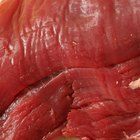Davide Ferretti/iStock/GettyImages
A beef Florentine roast makes an impressive main course for a dinner party when you slice it to reveal the filling in a pinwheel shape. Although "Florentine" can refer to the cooking style in Florence, Italy, Florentine-style usually means a food is cooked with spinach and, in many cases, an Italian cheese. You can make a beef Florentine roast from any boneless beef roast, such as a beef tenderloin, an eye of round roast, rump roast or sirloin roast.
Trim the excess fat from the outside of the roast with a boning knife.
Butterfly the roast so it's flat and lays open, which basically involves cutting the roast in a spiral. Moving your knife parallel to the cutting board, slice into the roast almost all the way across, stopping about 1/2 inch to 1 inch before cutting all the way through. Open up the two halves like a book. You might need to pound the roast a bit with a meat mallet to make it lay flat when finished.
Cover the meat with a layer of fresh spinach leaves. Drizzle olive oil lightly over the spinach, and add your choice of spices, such as salt, black pepper and Italian seasonings like basil and oregano. Top the spinach with a thin layer of your choice of cheese, if desired, like provolone, Parmesan, Asiago, mozzarella or a blend of cheeses.
Roll up the meat with the spinach and cheese inside, starting from one long edge and working to the opposite edge, like you would roll up a carpet.
Tie up the roast with butcher's twine to keep it from unrolling, starting about 1 inch from the end and continuing every 2 inches. You can cut individual lengths of twine, if desired, or tie the roast with a continuous length of string. After tying the first loop, make a large loop in your hand, slide it under the roast and position it 2 inches down from the first tie. Pull the string tight, make a second loop, slide it under and pull it tight to make a third tie, repeating this process down to about 1 inch from the opposite end.
Place the roast in a baking dish. Sprinkle salt and pepper over the outside of the roast. You can also drizzle olive oil over the roast and sprinkle an Italian seasoning blend over top. Preheat the oven to about 350 to 400 degrees Fahrenheit.
Bake the roast for about 15 to 20 minutes per pound, or until the beef reaches the desired internal temperature. Choose a lower temperature and longer cooking time tough cuts of beef such as chuck roasts, and a higher, faster cooking method for lean, tender cuts such as tenderloin. Use a meat thermometer to determine doneness. Remove the roast at 120 F for rare, 125 F for medium-rare, 130 F for medium, 135 F for medium-well or 140 F for well done roasts. The cooking time for a rare roast might not be enough to cook the spinach through.
Remove the beef florentine roast from the pan, and let it rest for at least 3 minutes. Slice the roast into pinwheels for individual servings. Use the strings as a guide, cutting at the center between two strings. Remove and discard the strings.
Related Articles

How to Cook a Beef-Pork Combo Roast

How to Fold a Pocket Square Using a Tie

How to Slow Cook a Rolled Rib of Beef

How to Trim and Tie a Beef Tenderloin

How to Tie a Square Knot Necktie

How to Fix a Tie

How to Cook a Boneless Top Sirloin ...
How to Cook a Rolled Roast Medium Rare

How to Cook Stuffed Flank Steak With ...

How to Tie a Man's Tie in the European ...

How to Cook a Country Sausage Stuffed ...

How to Cook Spinach in the Oven

How to Cook a Bottom Round Roast on a ...

How to Cook a 15-Pound Rib Roast
Tips on How to Cook a Spiral Ham

How to Tie a Zipper Tie

How to Pluck Your Eyebrows With Strings

How to Measure and Cut a Wedding Veil

How to Cook a Choice New York Roast

How to Attach Stampede Ties to a Cowboy ...
References
Tips
- Butchers typically tie roasts with a butcher's knot. When you gather the two ends, instead of wrapping the string just once, wrap the short end two or three times around the long end of string.
Writer Bio
A former cake decorator and competitive horticulturist, Amelia Allonsy is most at home in the kitchen or with her hands in the dirt. She received her Bachelor's degree from West Virginia University. Her work has been published in the San Francisco Chronicle and on other websites.